
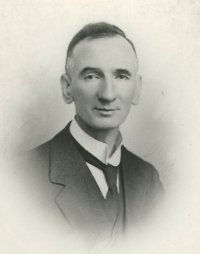
Alexander Crichton Mitchell
 |
If you have any feedback please email me: Dr Richard Walding Research Fellow - School of Science Griffith University Brisbane, Australia Email: waldingr49@yahoo.com.au |
Mitchell was born in Edinburgh on 1 July 1864 to James Mitchell and Isabella Mitchell (nee Crichton). He studied physics under Professor Tait at Edinburgh University from 1883 to 1890 and in that time he was awarded a BSc and DSc (and an Hon. DSc in Geneva) for his studies into thermal conductivity of metals (see list at end). In 1890 he was appointed Professor of Mathematics and Physics at His Highness The Maharajah's College at Trivandrum in India. He volunteered to become Director of the Trivandrum Observatory the following year as he was so dismayed at the run-down condition of the observatory and the inaccuracy of data collection. He took up residence in Ross House, now known as Rose House - opposite Women’s College. He took classes in mathematics and English and prepared students for the exams administered by Madras University, to which The Maharaja's College was affiliated. To hear him recite Hamlet in a broad Scottish accent to Indian students was the stuff of legends. Mitchell was soon appointed to the Board of Examiners at Madras University.
In 1893 he was promoted to Principal and continued in this joint role until 1909 when he was appointed Director of Public Instruction for the State of Travancore, India. He is known to have visited all of the schools under his authority - mostly by motorcycle. On one trip to Bishop Hodges school in Mavellikera he is reported to have had a accident on his motorcycle as he passed over a culvert. The area is known as Mitchell Junction to this day. His work in revising the Education Code in 1910 is still recognised by the current government of Kerala (India) as being one of the finest pieces of legislation enacted in the State. During this time, Mitchell and his wife Agnes had three children: Alan, Steuart and Margaret - all born at the Women's Hospital in Trivandrum. He was a much loved professor by staff and students alike. Even though he had quite a gruff manner he actually had a heart of gold. He is fondly remembered as handing out money to students who were found a bit short of money for their textbooks and so on. He made annual trips back to Edinburgh to visit his family (who had left Travancore soon after their youngest reached school age - about 1905). On his annual furlough in Edinburgh he continued with his research and was able to keep up to date with latest developments in meteorology and geomagnetism. It seems that he may have also visited the Kodaikanal Magnetical Observatory in Tamil Nadu during a semester break.
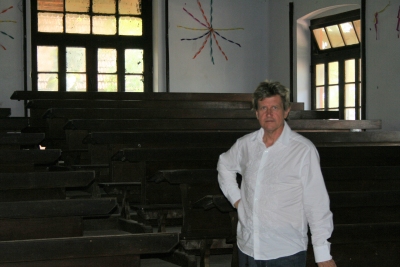 Me, In Mitchell's lecture theatre in Trivandrum |
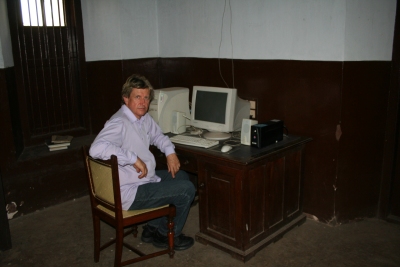 In Mitchell's chair at the Trivandrum Observatory |
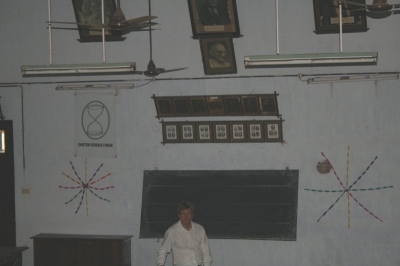 At front of Mitchell's lecture hall. Mitchell's portrait is above that of Gandhi on the wall behind. |
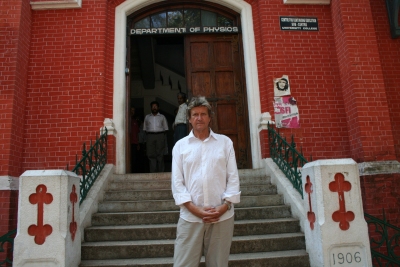 In front of Mitchell's Physics building at University College, Trivandrum. Inscription says "1906" - when the building was opened. I was assured that Gandhi stood on these very steps. |
In 1912 Mitchell retired and returned to his family in Edinburgh on a very generous lifetime pension. He was at somewhat of a loose end and chose to become an Honorary Research Fellow at Edinburgh University, and a Committee Member of the Royal Society of Edinburgh (RSE). Just after the start of the war, the RSE was contemplating how it could assist in scientific research to help the war effort. It was well known that German U-Boats began coming into Firth of Forth up to Inchkeith Boom defences. But the events of April 1915 certainly heightened RSE's drive: on the 21st the Swedish steamer Ruth from Leith was torpedoed by U-Boat off May Island [1] and then a week later the German Professor of Ship Construction Dr Flamm wrote in the German newspaper Vossische Zeitung that the U-Boat would destroy The British Empire by restricting trade, particularly by blocking key ports such as the Firth of Forth [2].
On 7 June 1915 the RSE received a donation from a very generous benefactor providing funds for the purpose of investigating method of detecting German submarines. This galvanised Mitchell who volunteered to undertake antisubmarine research in the Forth. On 25 June permission given to Mitchell by the Admiralty and The Leith Dock Commission for him to conduct experiments off West Pier, Leith. The list of war deaths of Cambridge men in The Times that same day shook them all. Mitchell remembered an incident during some research into the conductivity of ice in 1886. He was on the roof of the Physics building in Edinburgh when an aurora in the northern sky sent his galvanometer haywire [Mitchell, 1887]. He tucked away in his mind that changes in earth's magnetism would produce an electric current in a loop of wire.
Back to 1915 in Leith: Mitchell suspended a loop of bell wire vertically over the side of the pier and waited for a steel ship to pass. A tiny current was registered on his galvanometer. He then put the loop horizontally on the seafloor and obtained a much larger reading. The electrical interference from Leith trams was a problem, but he solved this by twisting the loop into a figure-of-eight. This became the basis for his "indicator loop". His work continued until 20th August and his results were reported to the RSE and were sent on to the Board of Investigation and Research in London (where they lay for three years). Mitchell wanted to continue his trials with a bigger loop and a submarine. On 20 August Mitchell met with Cmr Haggard (OIC HMS Vulcan) and Captain Ryan (in charge of the Hawkscraig Experimental Station) to arrange for loop equipment to be taken to the deep water off Inchkeith. Ryan provided some of his hydrophone cable (Service Pattern 841B with gutta percha insulation) and access to the British sub "B3".
Mitchell spent most of day at Inchkeith and over the next few weeks trialled his indicator loop in a more realistic situation. He had spent a grand total of £12 on his work by this stage. The results were a success and an indicator loop cable (4 core armoured lead sheathed) was later laid across the Forth. However, as Adm Roger Keyes noted: electrical interference from the Edinburgh to Leith trams spoilt the results and the loop was removed [3]. Mitchell's work was finished. On 17 April 1916 he was appointed Superintendent of the Eskdalemuir Magnetical Observatory 100 km south of Edinburgh. His "loop" report for the RSE lay dormant in London until Professor William Bragg read through the old files and found it. Bragg began a program of loop research when he moved his team from Hawkscraig to Harwich in January 1917 but more than a year had been lost. In November 1919 Mitchell obtained some of the loop cable from Hawkscraig (for free) for use in his terrestrial magnetism research program at Eskdalemuir. In 1915 Mitchell undertook experiments on the detection of submarines for the Royal Society of Edinburgh and in 1916 was appointed to the Eskdalemuir Geomagnetic Observatory as Director and continued in this role until his retirement in 1924.
Mitchell made considerable original contributions to meteorology and geomagnetism, publishing a dozen papers mainly in the journals of the Royal Society of Edinburgh. He won the RSE's Keith Medal in 1933 for his work on geomagnetism.
In 1912 Mitchell retired and took leave until 1914 and in this time continued as a research fellow at Edinburgh University. He then undertook his antisubmarine indicator loop research for the Royal Society of Edinburgh until 1916 when he was appointed as Director of the Eskdalemuir Magnetical Observatory in southern Scotland. An article about my work in Trivandrum can be found in The Hindu on-line at The Hindu : Metro Plus Thiruvananthapuram : An irresistible attraction.
In 1922 he became the first superintendent of the then newly-established Meteorological Office headquarters in Edinburgh. Although he published several papers on the diurnal variation of temperature and pressure and played an important part in the reorganization of meteorological work in Scotland, he was primarily a geophysicist. It was for his studies of terrestrial magnetism that he was best known. To this he devoted an immense amount of painstaking research, which included latterly a valuable review of the subject in its historical aspect. Seismology was among his principal subsidiary interests. In collaboration with J. J. Shaw he contributed to the Dictionary of applied physics the article on seismometry.
Much of Crichton Mitchell's time was given in the service of the Royal Society of Edinburgh, to the company of whose Fellows he was admitted in 1889. For many years he was curator of the library, and from 1926 to 1929 he held the office of vice-president. That Society's 1931-33 Keith Prize was awarded to him for his work on the diurnal incidence of disturbance in the terrestrial magnetic field. From 1928 to 1937 he was a member of the Advisory Committee on Meteorology for Scotland. Possessed of tireless energy and unbounded powers of concentration himself, Crichton Mitchell could not brook slackness or lack of enthusiasm in his associates. To him work was the raison d'etre of life and so he felt, it should be to others.
On one occasion, some 25 years ago, he invited a young Scottish scientist who was about to enter the service of the Meteorological Office at Edinburgh to visit him for a discussion of the forthcoming appointment and its prospects. The invitation was for breakfast time - 8-15 am. On arrival the guest ventured to express surprise at finding his host hard at work, so early in the day 'I've been at it for four hours,' boomed the senior man in his deep voice. Crichton Mitchell was given to plain speaking and seldom minced his words in any company. These qualities - his bluntness and his intolerance of slovenliness or inefficiency - won him the respect of all with whom he had to deal, though naturally not always their affection.
Dr Crichton Mitchell retired front his official duties in the government meteorological service on reaching the age of 60 in 1925. But with him retirement did not mean leisure. For another 27 years he laboured on, seeming to need little relaxation even in advanced old age. Until a short while before his death he was still busily planning further lines of research. He died in Edinburgh on 15 April 1952.
Alexander Crichton Mitchell married Agnes Farquharson Robertson on 2nd May 1892 (d 1948) and had children Alan Crichton Mitchell (b 14 Dec 1897, d 1951), Steuart Seton Crichton Mitchell (b10 Mar 1902, d1991) and Margaret Enid Crichton Mitchell (b 28 Feb 1907, d 1986).
1. The Times, Monday, Apr 26, 1915; pg. 5
2. The Times Friday, Apr 30, 1915; pg. 8.
3. "The naval memoirs of Admiral of the fleet Sir Roger Keyes: Scapa Flow to the Dover Straits, 1916-1918" E. P. Dutton & Co., 1935, page 145. Keyes said that they were then successfully used with mines (in 1918 probably at Dover).
Please note: Dr. A. Crichton Mitchell's first name is 'Alexander'. In one prominent obituary from the time of his death he was named as 'Arthur'. This is incorrect.
PAPERS
| Date | Title | Journal Name | Vol | Pages |
| 1878 | Tait: Thermal and electrical conductivity (not ACM's paper) | TRSE | 28 | 717-740 |
| 1881 | Pyrometer | Encyclopaedia Britannica | XX | 129 |
| 1886 January | Account of a Preliminary Experiment on the Thermal Conductivity of Ice | PRSE | 13 | 592-596 |
| 1887 | On the thermal conductivity of iron, copper and german silver. Tait wrote the introduction. | TRSE | 33 | 535-560 + 2 plates |
| 1887-1890 | On the Thermal Conductivity and Specific Heat of Manganese-Steel | TRSE | 35 | 947-954 |
| 1889 | Read paper to RSE, 1 April, 1 July | |||
| 1900 | On the Convection of Heat by Air Currents | TRSE | 40 | 39-49 + 1 plate |
| 1916 | Summary of some important investigations carried out by Dr G W Walker, head of the Indian Met Dept | J Scottish Met Soc | ||
| 1917 | The Diurnal Incidence of Disturbance in the Terrestrial Magnetic Field (awarded Keith Prize for 1931-1933; reported at 5th Ordinary Meeting of RSE, Monday 5 March 1934; see PRSE 1934, Appendix, p232). | J Scot Met Soc | 17 | 156-165 |
| 1918 | Seismic Disturbances connected with the Guatemala Earthquake | Nature | Feb 28 No 2522, Vol 100 | 514-515 |
| 1919 | On the Pulsations of the vertical component of terrestrial magnetic force (presented at RSE Meeting June 2, 1919) | (reported in PRSE but not published) | 39 | 255 |
| 1920 | The Magnetic Storm of March 22-23 and Associated Phenomena | Nature | April 8 | 170 |
| 1921 | The magnetic storm of May 13-17 | Nature | May 26 | 392-393 |
| 1923 | On the Vertical Force Changes during a “Sudden Commencement” of a Magnetic Storm | PRSE | 45 | 297 |
| 1924 | On the diurnal variation of atmospheric pressure at Eskdalemuir and Castle O’er Dumfries-shire | QJRMS | 50 | 127-135 |
| 1924 | Gravitation | Chambers Encyclopaedia | V | 372-373 |
| 1932 | Chapters in the History of Terrestrial Magnetism I | Terr. Mag. and Atmos. Electricity | 37 | 105-146 |
| 1933 | The Diurnal Incidence of Disturbance in the Terrestrial Magnetic Field. Submitted at 4th Ord Meeting of RSE, Monday 6 February 1933; recorded in PRSE, p391, 1933 | TRSE | 57 | 617-632 |
| 1937 | Chapters in the History of Terrestrial Magnetism II | Terr. Mag. and Atmos. Electricity | 42 | 241-280 |
| 1939 | Chapters in the History of Terrestrial Magnetism III | Terr. Mag. and Atmos. Electricity | 44 | 77-80 |
| Pub 1950 Washington | Stationary Loop. Also a reference in Terr Mag & Atm Elect V53, 1948 report on Oslo meeting by Joyce page 455. | Trans. Of the Oslo Meeting of the Int Union of Gedosy and Geophysics | 327 | |
| 1951-1952 | Obituary | Year Book RSE | 38-40 | |
| 1952 | Obituary | QJRMS | 78 | 657 |
| 1952 | Obituary | Met Mag | 81 | 189 |
TECHNICAL
How an indicator loop works